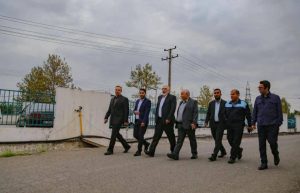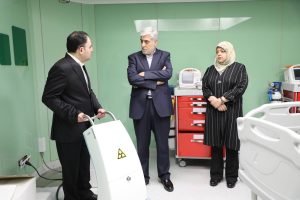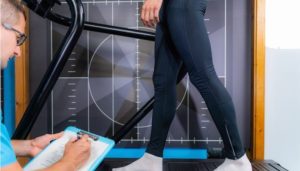
Iran become leader in ME`s robotic surgery
Barekat Health and Pharmaceutical Group: In recent decades, technological advancements, particularly in robotic surgery, have fundamentally transformed treatment methods. Cutting-edge technologies in robotic surgery, through enhanced precision, reduction of human errors, and increased safety in complex procedures, have played a crucial role in improving patient care. These advancements have not only increased access to complex surgeries worldwide but have also significantly improved the success rates of these procedures.
Iran, as a leading country in the Middle East, has recognized the importance of these innovative technologies and has made significant investments in the development and localization of robotic surgery. Particularly in recent years, extensive efforts have been made to equip hospitals with robotic surgical systems and to train specialized surgeons. These efforts have enabled complex surgeries, once only feasible in advanced countries, to be performed with the same precision and safety in Iran.
What is Robotic Surgery?
Robotic surgery employs advanced technologies such as artificial intelligence, virtual reality, and complex robotic systems to bring unprecedented precision to the medical field. Surgeons use remote control systems to perform surgeries with millimeter accuracy, which significantly reduces surgical errors and improves treatment outcomes. Additionally, minimally invasive surgeries using robots reduce patient recovery times and lower the risks associated with open surgeries.
History of Robotic Surgery Worldwide
Robotic surgery emerged as a medical innovation in the 1980s and has since undergone significant advancements. Early robotic systems were designed to enhance precision in complex surgeries and reduce human errors. Among these, the da Vinci system emerged as a pioneer, introducing new standards in minimally invasive surgeries by combining advanced robotics, imaging, and artificial intelligence technologies.
In recent decades, the use of robots in various surgeries, including heart, kidney, brain, and even eye and ear surgeries, has expanded. This trend, driven by the unique advantages of robotic surgery such as high precision, reduced recovery times, and lower risks of open surgeries, continues to grow rapidly.
Introduction of Robotic Surgery to Iran
Iran began efforts to introduce and develop robotic surgery technologies in the early 2000s, recognizing their importance in improving patient care quality. The first robotic surgery in Iran was performed at a hospital in Tehran, and since then, the use of this technology has spread to various hospitals across the country.
In recent years, supported by government backing and investments in the healthcare sector, the number of hospitals equipped with robotic surgical systems has increased. Iranian surgeons have successfully performed complex operations using this technology, particularly in urology, cardiology, and gastrointestinal surgeries.
Innovative Technologies in Robotic Surgery
The technologies used in robotic surgery include a combination of various scientific and technological fields:
– Remote Control Systems: Robotic surgical systems allow surgeons to perform complex operations with high precision remotely using control consoles. These systems provide enhanced accuracy by transmitting 3D and magnified images of the surgical site, while robotic hands offer millimeter-level movements for surgeries in sensitive and complex areas.
– Artificial Intelligence in Robotic Surgery: Artificial intelligence, a key component of robotic surgical systems, enhances precision and safety. It assists surgeons by analyzing patient data, predicting surgical outcomes, and suggesting optimal treatment methods. Machine learning algorithms enable robotic systems
to improve their performance over time based on previous surgical experiences.
– Advanced Imaging and Virtual Reality: Advanced imaging and virtual reality technologies allow surgeons to perform accurate simulations of surgical procedures before actual operations. These techniques are particularly useful in complex surgeries like neurosurgery and help reduce potential errors.
Advantages of Robotic Surgery
Robotic surgery has achieved a prominent position in Iran’s medical field due to its numerous benefits. Surgical robots minimize errors caused by hand tremors and other issues associated with manual surgeries. This precision is crucial for surgeries requiring small, accurate incisions, such as brain and nerve surgeries. Moreover, the minimally invasive nature of robotic surgery reduces recovery times by avoiding large incisions and minimizing internal damage, leading to quicker patient recovery and fewer post-surgical complications.
The expansion of robotic surgical systems in various Iranian hospitals has increased patient access to complex procedures previously available only in specialized centers. This is especially significant for patients in remote and less developed areas.
Challenges & Obstacles
Despite the advantages, robotic surgery in Iran faces several challenges that require careful attention and planning. One of the major challenges is the high cost of the necessary equipment and technologies, which limits access for hospitals and increases the cost of surgeries for patients.
Successful implementation of robotic surgeries also requires precise and specialized training for surgeons. While Iran has made efforts in this area, there is still a need for more extensive training programs and specialized surgeon development. Additionally, developing the technological infrastructure needed for robotic systems, including advanced communication networks, imaging systems, and data processing capabilities, requires further investment.
R&D in Advancing Robotic Surgery
Research and development (R&D) play a critical role in advancing and improving robotic surgery technologies. Countries that have made progress in this field typically possess strong research and innovation systems. In Iran, with its scientific capabilities and specialized human resources, there is significant potential for developing research related to robotic surgery. One effective strategy to reduce dependence on foreign technologies is the development of domestic robotic surgical systems, which can lower costs and increase access. Research institutes and universities can play a central role in this endeavor.
Scientific collaborations with international universities and research centers, particularly in countries leading in robotic surgery, can facilitate knowledge and technology exchange through joint research projects, training programs, and expert exchanges.
Economic Aspects of Robotic Surgery
The economic dimensions of robotic surgery are crucial and must be considered. Given the high costs of equipment and infrastructure, examining the economic aspects of this technology is vital.
– Funding and Investment Models: Developing suitable funding and investment models for expanding robotic surgery in Iran is essential.
These models might include private sector partnerships, government support, and the creation of special investment funds for advanced medical technologies.
-Cost-Benefit Analysis: Cost-benefit studies in robotic surgery can inform decisions about technology development. These studies should consider long-term benefits such as reduced treatment costs due to fewer post-surgical complications and increased patient satisfaction.
Role of Regulatory Bodies and Policy-making
Regulatory bodies and policymakers play a crucial role in shaping the development of robotic surgery in Iran. Key actions include:
– Developing Regulations and Standards: Establishing specific regulations for robotic surgical technology, including import and usage licenses, can support the field’s growth. Creating safety and quality guidelines can enhance trust in these technologies within the medical community.
– Supporting Innovation and Entrepreneurship: Encouraging innovation and entrepreneurship in robotic surgery can drive the development of new technologies and improvements in existing systems. Establishing innovation centers and science parks focused on robotic surgery can be an effective approach.
Establishing comprehensive training programs for robotic surgery specialists, including specialized courses, practical workshops, and international collaborations, should be prioritized
Future Outlook
To optimize the use of robotic surgery technologies in Iran and expand their application nationwide, several strategies and recommendations should be considered. Establishing comprehensive training programs for robotic surgery specialists, including specialized courses, practical workshops, and international collaborations, should be prioritized.
Government support for hospitals and healthcare centers to acquire and use robotic systems, along with the development of necessary technological infrastructure, will aid in the broader adoption of these technologies. Collaboration with advanced countries in robotic surgery for knowledge and experience exchange can enhance the skills of Iranian surgeons and improve robotic system performance in the country.
Conclusion
Robotic surgery represents one of the most significant advancements in modern medicine, offering enhanced precision, reduced errors, and improved patient safety. In Iran, leveraging scientific potential and specialized human resources can improve healthcare services and public health.
However, the development of robotic surgery requires addressing challenges, including the need for precise policy-making, appropriate investments, and specialized training. With coordinated efforts across various sectors, Iran can become a leader in robotic surgery in the region and harness the benefits of this technology to improve community health.
-
Barekat Health & Pharmaceutical Group at the 10th Iran Pharma Exhibition

-
Ali Safa visits Sobhan Oncology & Sobhan Darou

-
Pirsalehi & Safa visit Saman Daroo 8 Knowledge-based Company

-
Barekat Managing Director Visits Samen Pharmaceutical Company

-
Honoring Pharmacists’ Day

-
Barekat Top Executives Visiting to Barekat Hospital

-
Alborz Darou honored as Top Exporter of Qazvin Province in 2024

-
Footsteps & Gazes of Disease: A Revolution in Early Diagnosis

